Screen flickering on medical displays can seem like a minor annoyance. However, its subtle effects can significantly impact clinical work. I understand that consistent, stable imaging is crucial for medical professionals who rely on visual data.
Screen flickering negatively impacts clinical use by causing visual discomfort and fatigue in clinicians, potentially compromising image accuracy and diagnostic reliability, especially in visually demanding medical specialties like radiology and surgery.
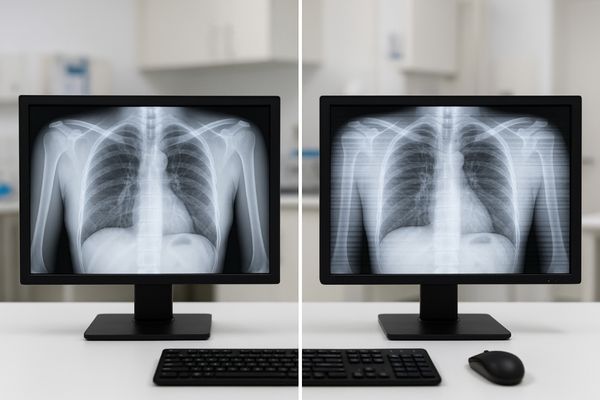
The visual interface is a critical component in modern medicine. Clinicians depend heavily on displays for diagnostics, interventions, and patient monitoring. Imperfections in display performance, such as screen flickering, can have far-reaching consequences. These effects are not always immediately obvious. They can subtly degrade performance and well-being over time. I will explore the various ways screen flickering can affect clinical practice. This discussion will cover its causes, its impact on users, and how advanced display technologies address this pervasive issue. Understanding these factors is essential for selecting equipment that supports optimal clinical outcomes.
What causes screen flickering in medical displays?
You might notice an annoying flicker on a screen, especially at lower brightness. This is not just a minor flaw. It often points to underlying technological choices in the display’s design that can impact your viewing experience.
Screen flickering in medical displays is primarily caused by Pulse Width Modulation (PWM) dimming for brightness control, low refresh rates, unstable backlight circuitry, or delays in image processing, often becoming more noticeable at reduced brightness levels or during prolonged periods of use.
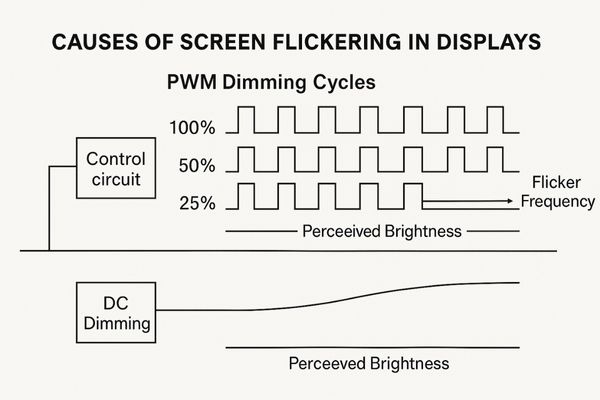
Several technical factors contribute to the phenomenon of screen flickering in medical displays. One of the most common culprits is a backlight dimming technique called Pulse Width Modulation (PWM)1. PWM works by rapidly switching the backlight on and off at high frequencies. The ratio of ‘on’ time to ‘off’ time determines the perceived brightness. While this method is cost-effective and efficient for controlling brightness, the rapid cycling can be perceived as flicker, especially by sensitive individuals or at lower brightness settings where the ‘off’ periods are longer. Another significant cause is a low refresh rate2. The refresh rate indicates how many times per second the image on the screen is updated. If this rate is too low, the human eye can perceive the gaps between refreshes, resulting in a flickering effect. Unstable backlight control circuitry, which fails to maintain a consistent power supply to the LEDs or CCFLs illuminating the screen, can also introduce visible flicker or shimmer. Furthermore, delayed or inconsistent image processing within the display’s internal electronics can sometimes manifest as a less stable image. Our MD10C – 1MP Diagnostic Monitor, like all our displays, is engineered to minimize these factors, focusing on stable image presentation for reliable diagnostic viewing. These issues are often exacerbated when the display is used for extended durations, as continuous exposure makes even subtle flicker more apparent and bothersome.
Understanding Backlight Dimming Techniques
The method used to control screen brightness is a primary determinant of flicker. Two main techniques are prevalent:
| Dimming Technique | How it Works | Flicker Potential | Brightness Control Quality |
|---|---|---|---|
| Pulse Width Modulation (PWM) | Rapidly cycles the backlight on and off. Brightness depends on on/off ratio. | High | Can be precise |
| Direct Current (DC) Dimming / Constant Current | Adjusts the continuous current flowing to the backlight. | Low / Negligible | Smoother, less precise at very low levels |
While PWM can offer precise brightness control across a wide range, DC dimming, also known as constant current dimming, is generally preferred for reducing or eliminating flicker, thereby enhancing visual comfort.
How does flicker affect clinician visual comfort and fatigue?
Clinicians spend many hours looking at screens. Constant, even imperceptible, flickering can take a toll. This leads to more than just annoyance; it can affect their ability to work effectively.
Extended exposure to flickering displays causes significant visual discomfort, including eye strain, dry eyes, blurred vision, and headaches. It also contributes to increased mental fatigue and reduced concentration, negatively impacting a clinician’s overall well-being and endurance during long shifts.

The impact of screen flicker on visual comfort3 and clinician fatigue is a serious concern. The human visual system is highly sensitive to inconsistencies in light. Even if the flicker is not consciously perceived as distinct on-off cycles (often called "invisible flicker"), the eye and brain still attempt to process these rapid modulations in brightness. This subconscious effort places an additional burden on the visual processing pathways. Over prolonged periods of screen time, which are very common in clinical environments, this added strain can manifest in a range of symptoms collectively known as Computer Vision Syndrome4 (CVS) or digital eye strain5. Common complaints include eye fatigue, a sensation of dryness or grittiness in the eyes, blurred vision, difficulty refocusing, and even general headaches or neck and shoulder pain from associated postural strain. The MD22CA – 2MP Diagnostic Monitor is designed with features that promote visual comfort, acknowledging the long hours clinicians spend in front of displays. Flickering displays can also contribute to increased mental fatigue. The constant visual adjustment, however slight, demands more cognitive resources, leading to a faster depletion of concentration and a reduced ability to maintain focus on complex diagnostic tasks or intricate surgical procedures. This is particularly problematic in high-stress, information-dense medical settings where sustained attention is paramount for patient safety.
Can flickering compromise image accuracy and diagnostic reliability?
Diagnostic decisions often rely on subtle visual cues. If a screen flickers, even subtly, it might interfere. This interference could make it harder to see important details necessary for an accurate diagnosis or precise intervention.
Yes, screen flickering can compromise image accuracy and diagnostic reliability. Even subtle flicker can distort the perception of fine details such as edges, textures, or grayscale gradations, potentially leading to misinterpretations or missed findings, especially in precision-critical tasks like mammography, radiology, or microsurgery.
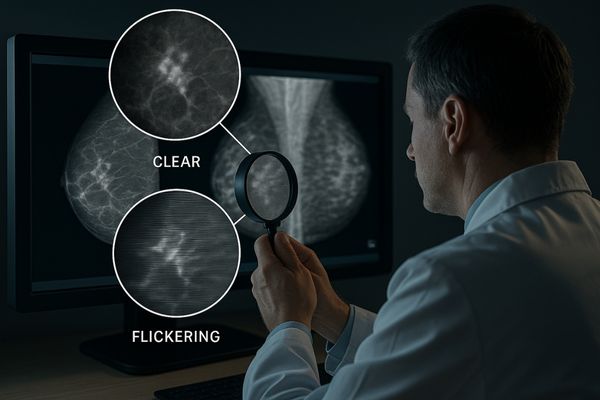
The potential for screen flickering6 to compromise image accuracy7 and, consequently, diagnostic reliability8 is a significant concern in medical imaging. Many diagnostic tasks require the clinician to perceive very subtle visual information. For instance, in radiology, detecting faint nodules, fine calcifications in mammography, or subtle changes in tissue density relies on the clear and stable presentation of grayscale gradations and edge definition. If a display exhibits flicker, these minute details can become more difficult to discern accurately. The rapid, often imperceptible, changes in luminance caused by flicker can effectively "muddy" the visual information. This can obscure delicate textures or make it harder for the eye to consistently track edges and contours. In dynamic imaging, such as during endoscopic procedures or ultrasound examinations, flicker can interfere with the perception of motion and the clarity of moving structures. This interference might lead to a misjudgment of depth, size, or the true nature of a lesion. Our MD26GA – 2MP Diagnostic Monitor prioritizes stable and accurate image reproduction to support reliable diagnostic interpretation. Even if flicker does not lead to a direct misdiagnosis, the increased visual effort required to extract information from a flickering screen can slow down the diagnostic process and increase the likelihood of oversight due to fatigue. In fields like pathology, where subtle color variations and cellular morphology are critical, any instability in image presentation can be detrimental to accurate assessment.
Are certain clinical departments more sensitive to flickering issues?
Some medical tasks require intense visual focus for long periods. In these situations, screen flicker is not just an annoyance. It becomes a direct impediment to the quality and efficiency of care.
Yes, clinical departments where professionals, such as radiologists, pathologists, and surgeons, spend extensive hours scrutinizing detailed images on screens are particularly sensitive to flickering issues. In operating rooms, the combination of flicker and bright ambient lighting can significantly intensify visual discomfort and strain for the surgical team.
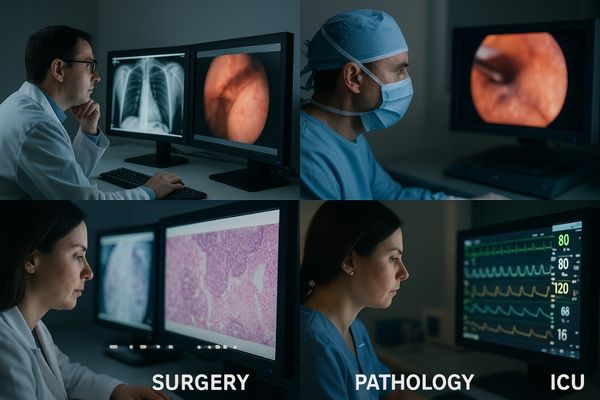
While screen flicker9 can be detrimental in any clinical setting that utilizes digital displays, some departments and roles are inherently more susceptible to its negative effects. Radiologists are a prime example. They spend the majority of their workday meticulously examining complex medical images on multiple high-resolution displays, searching for often subtle signs of disease. The prolonged, intense visual scrutiny required makes them highly vulnerable to flicker-induced eye strain10, fatigue, and potential diagnostic inaccuracies. Similarly, pathologists who analyze digital slides also engage in extended periods of detailed screen work, where image stability is paramount for identifying minute cellular abnormalities. Surgeons, especially those performing minimally invasive procedures, rely heavily on surgical displays for real-time visual guidance. In the bright environment of an operating room, any flicker from the display can be exacerbated by reflections and ambient light, leading to heightened visual discomfort and potentially impacting hand-eye coordination during critical maneuvers. The MD32C – 3MP Diagnostic Monitor11, with its higher resolution, caters to specialties demanding fine detail, where flicker mitigation becomes even more crucial. Intensive Care Units (ICUs) and emergency departments, where clinicians continuously monitor patient vitals and imaging data on various screens, often under high-stress conditions, are also areas where flicker can contribute to staff fatigue and reduce situational awareness. Any role that demands prolonged, focused attention on screen-based information will experience greater negative impacts from display flicker.
Sensitivity Levels to Screen Flicker Across Medical Specialties
Different medical specialties have varying degrees of reliance on continuous, detailed screen viewing, which correlates with their sensitivity to display flicker.
| Medical Specialty | Primary Screen Task | Typical Duration of Screen Use | Flicker Sensitivity | Potential Impact of Flicker |
|---|---|---|---|---|
| Radiology | Detailed image interpretation, diagnosis | Very High (hours daily) | Very High | Eye strain, fatigue, missed diagnoses, reduced reading speed |
| Pathology (Digital) | Microscopic image analysis, cellular assessment | High (hours daily) | High | Visual fatigue, errors in cell morphology assessment |
| Surgery (Minimally Invasive) | Real-time surgical field visualization | Moderate to High (per procedure) | High | Eye strain, reduced hand-eye coordination, increased stress |
| Cardiology (Cath Lab) | Angiography, intervention guidance | Moderate (per procedure) | Moderate to High | Visual discomfort, potential misjudgment of vessel details |
| Ophthalmology | Retinal imaging, OCT scan review | Moderate | High | Difficulty discerning fine retinal structures |
| General Ward/ICU | Patient monitoring, EHR review | Intermittent to Moderate | Moderate | General fatigue, reduced efficiency in data review |
This table illustrates that specialties involving prolonged and detailed image analysis are most affected, making flicker reduction a critical design consideration for displays used in these areas.
How does Reshin reduce flickering in its display technology?
Addressing screen flicker is not just about user comfort. It is fundamentally about ensuring image quality and reliability for critical medical tasks. We take this responsibility very seriously in our display design and engineering processes.
Reshin reduces flickering by employing advanced flicker-free constant current (DC dimming) backlight technologies, optimizing refresh rates to at least 60Hz, implementing sophisticated image stabilization algorithms, and incorporating automatic brightness compensation systems to ensure both superior image fidelity and sustained user comfort.
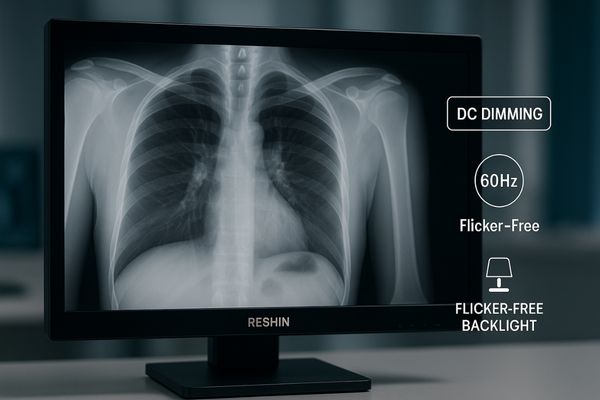
At Reshin, we are acutely aware of the detrimental effects screen flicker can have in clinical settings. Therefore, we integrate multiple advanced technologies into our medical displays specifically to minimize or eliminate this issue. A cornerstone of our approach is the use of flicker-free backlight systems12, predominantly utilizing Direct Current (DC) dimming. Unlike PWM dimming, which rapidly switches the backlight on and off, DC dimming13 adjusts brightness by modulating the continuous electrical current supplied to the backlight LEDs. This results in a much more stable light output, significantly reducing the likelihood of perceptible or imperceptible flicker, even at lower brightness levels. We also ensure our displays operate with optimized refresh rates, typically at 60Hz or higher. This provides a smoother, more fluid image presentation, making it easier on the eyes during prolonged viewing. Our surgical monitors, such as the MS192SA – 19" HD Endoscopic Monitor, benefit from these stable imaging technologies, crucial for clear visualization during procedures. Furthermore, we implement sophisticated image stabilization algorithms14 within the display’s internal processing unit. These algorithms work to counteract any minor instabilities in the video signal or backlight performance, further contributing to a consistently steady image. Automatic brightness compensation is another feature that plays a role; by using ambient light sensors and internal feedback loops, our displays can maintain a consistent perceived brightness over time and across different environmental conditions, which indirectly contributes to a more stable visual experience by reducing drastic manual adjustments that might interact with flicker sensitivities. This comprehensive, multi-faceted approach ensures that Reshin displays deliver exceptional image fidelity while prioritizing the visual comfort and diagnostic confidence of medical professionals.
Conclusion
Screen flicker is a preventable issue in medical displays. Prioritizing flicker-free technology enhances clinician well-being, improves diagnostic accuracy, and ultimately supports better patient care outcomes in demanding clinical environments. To equip your facility with flicker-free medical display solutions, contact Reshin at martin@reshinmonitors.com.
-
Understanding PWM is crucial for grasping how backlight dimming can lead to flickering, especially in medical displays. ↩
-
Exploring the impact of refresh rates can help you understand the technical aspects of display performance and flickering issues. ↩
-
Exploring ways to enhance visual comfort can lead to better working conditions and reduced fatigue for clinicians. ↩
-
Understanding Computer Vision Syndrome can help you recognize symptoms and find effective solutions for visual comfort during screen use. ↩
-
Learning about digital eye strain can help you implement strategies to alleviate discomfort and improve eye health during prolonged screen use. ↩
-
Understanding the impact of screen flickering on medical imaging can help improve diagnostic reliability and patient outcomes. ↩
-
Learning about factors that influence image accuracy can enhance the effectiveness of medical imaging technologies and practices. ↩
-
Exploring diagnostic reliability can provide insights into improving patient care and ensuring accurate diagnoses in medical imaging. ↩
-
Understanding the effects of screen flicker can help improve work conditions for medical professionals and enhance patient care. ↩
-
Preventing eye strain is crucial for radiologists to maintain accuracy and comfort during long hours of image analysis. ↩
-
Exploring the advantages of a 3MP Diagnostic Monitor can reveal how it enhances image clarity and reduces flicker effects. ↩
-
Understanding flicker-free backlight systems can enhance your knowledge of display technologies and their benefits in clinical settings. ↩
-
Exploring DC dimming will provide insights into advanced display technologies that improve visual comfort and reduce flicker. ↩
-
Learning about image stabilization algorithms can help you appreciate the technology behind stable imaging in medical environments. ↩

